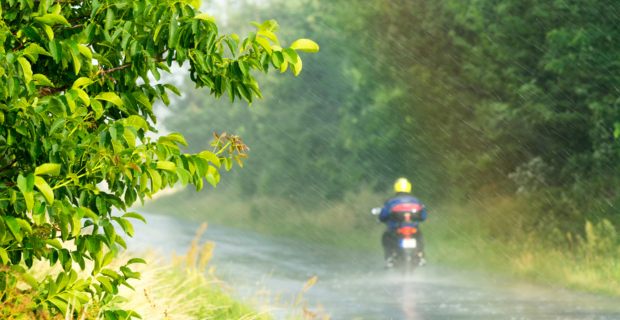Date Published: 2024/08/22
Read Time: mins
Safety tips for riding your motorcycle through the rain

More than likely, riding a motorcycle is a big part because you enjoy thrills and being one with nature. On the other hand, getting caught in a torrential downpour while riding is probably not your idea of a good time. Thanks to Canada's unpredictable weather, forecasts aren't always accurate—and rain showers can pop up just about anywhere. Knowing how to handle your bike in an unexpected rainstorm is so essential.
Why riding in the rain is so dangerous
So, what exactly makes riding in the rain so much more dangerous on a motorcycle? The main issue is that water hits the pavement and brings oils and other road debris to the surface. This can cause the roads to be extremely slick, especially during the first few minutes after it starts raining.
Rain can also affect visibility, especially for motorcycle riders who don't have the luxury of windshield wipers. All of this can make riding more dangerous.
How to stay safe if it starts to rain
It's always a good idea to check the weather forecast and avoid rain whenever possible on your motorcycle. Still, if you're hit with unexpected rain while you're riding, there are some tips to keep in mind.
1) Be prepared with the right gear
Start by making sure you have the right gear and equipment to stay safe. This should include highly visible and/or reflective gear that you can wear to help other drivers see you on the road. It's also a good idea to have a waterproof jacket and boots that will help you stay dry, as well as rain gloves to improve your grip.
2) Dial it back
If it does begin to rain while you're on the road, the first thing to do is to not panic. When you panic, you tend to make sudden and possibly rash decisions (such as hitting the brakes too hard or overcorrecting on a turn), which can lead to an accident. Instead, the main thing to keep in mind while riding in the rain is to simply scale back your inputs on your bike.
This means doing everything a little more slowly, including accelerating and braking. It's also a good idea to slow down (to the extent that it's safe to do so) and turn on your hazard lights to increase visibility in a heavy downpour.
3) Drive defensively
No matter how safely you may be riding, the reality is that you can't always count on other motorists to do the same. This is where having some defensive driving skills can come in handy. The basic idea behind defensive driving is to never assume that another motorist sees you or that they'll make the safe decision. While it's not fun to assume the worst of other drivers, it's important to be extra cautious—especially when riding in the rain.
4) Find a dry line
Riding on slick roads is dangerous, so if you find an opportunity to ride in a dry (or dryer) area of pavement safely, take it. Typically, the driest part of the pavement will be the area where there are tire tracks from other cars and trucks. As tires pass over these areas of pavement, they can actually displace some of the water on the road.
5) Know when to pull over
Last but not least, know when it's time to pull over in order to stay safe. If you see rain clouds approaching and aren't already wearing your rain gear, be proactive and stop at the next gas station to do so. If the rain is getting so heavy that you're having a hard time seeing in front of you or you can't find a dry line to ride the storm out, then it's probably time to stop.
If you do decide to pull over, try to do so at a gas station or similar location where you'll have some cover from the rain. Unless necessary, do not pull off to the side of the road during heavy rain.
Enjoy your ride
Getting caught in the rain isn't usually fun when you're riding a motorcycle, but with the right preparation and motorcycle safety tips in mind, you can keep yourself safer. And of course, over time, you'll become more comfortable and confident riding in the rain. Here are some tips for long-distance motorcycle rides.